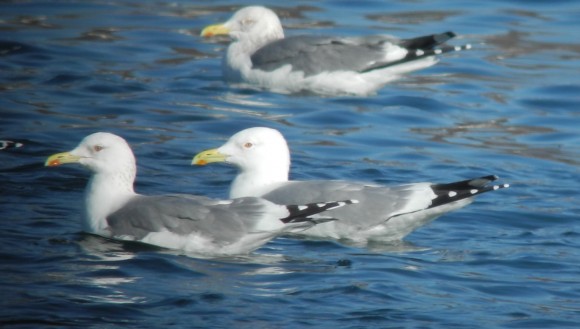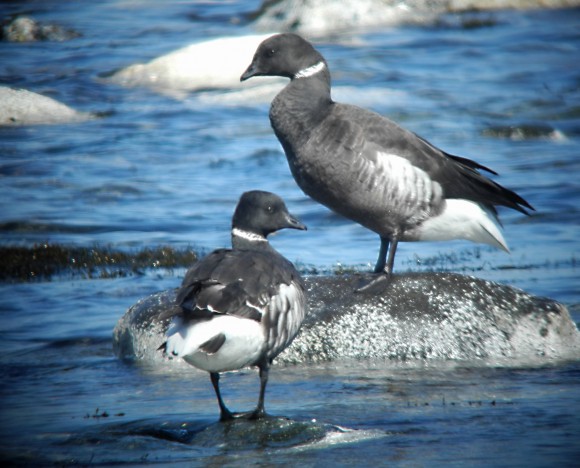Bird News from Nial Moores & Jason Loghry
In milder (min -2C/ max 6C), sunny conditions with only light winds (mostly W2, though occasionally up to Beaufort 3-4) some gulling at Guryongpo followed by some later afternoon birding close to Angang.
In the main harbour at Guyryongpo, along with very approximately 2,000 Black-headed, 200 Vega, 50 Black-tailed, 30 Taimyr, 20 Slaty-backed, 10 Common and 5 Mongolian Gulls and a single First-winter Black-legged Kittiwake, first bird of special note was a longish-billed adult Iceland Gull (seen only at long range- with no reason to suspect it to be different from the bird seen last month 15km or so to the north). This was followed soon after by an interesting adult gull seen within a group of Taimyr Gulls. Initially, ID was proposed (by NM) as a biggish-looking “eastern” Caspian – on the basis of its long-winged look, its long-bill and odd-shaped head, its beady eye (pale with some dark flecks), mid-grey saddle coloration (at different angles, consistently and obviously paler than taimyrensis, and one or two tones paler-looking than vegae, even in bright light), lack of any head-streaking, and grey-flesh toned legs. However, the bill depth, fuller-looking nape and especially the pattern on the underside of P10 seem a rather better match for a small-bodied adult Mongolian Gull – the default ID of most such white-headed gulls in this part of the world. Nonetheless, it was puzzling individual, and out of the range of what is usually expected of mongolicus here in the ROK. Identification of this bird seemed further complicated by the presence of a Slaty-backed Gull with some hybrid influence (most obvious in flight) and a presumed Taimyr Gull which also appeared long-billed and seemed to show more white in the outer primaries than might be usually expected (on the left of image captioned “Challenges of Gull ID)…
Further up the peninsula, happily much less challenging to ID were two Brant Goose (with the same or two more seen feeding further to the southwest), a dozen or so more Black-legged Kittiwake, several hundred Ancient Murrelet and probably c. 100 Rhinocerous Auklet in total.
At Angang, no Greater White-fronted Geese on the reservoir until after sun-down (when >1000 arrived), with best there several Eastern Buzzard, a Rough-legged Buzzard at least two Eurasian Eagle Owl and a suspected vulpinus Steppe Buzzard. This latter bird was ‘scoped at long range (soaring with upswept wings) for several minutes before it flew past us to roost in woodland. Although it looked long-winged, pale-headed and pale-tailed and showed strong white patches on the upperside of the primary bases (all briefly suggesting Upland), it otherwise looked small and its plumage was warm-toned. It had almost solidly-dark underparts below a narrow paler breast band, and extensive white on the underside of the black-tipped primaries with a striking white-looking or whitish stripe across the underwing offset only by dark carpal patches and underwing coverts and a dark trailing edge. Its tail was pale, grey-buff-orange toned at the base, with a clean-cut dark grey sub-terminal band. If some recent postings to listservers are correct, then vulpinus might not be so exceptional in Far East Asia. However, the inclusion of Steppe Buzzard Buteo buteo vulpinus within Common Buzzard by the IOC Checklist means we are in urgent need of much better East Asian-centric ID criteria…

 Mongolian Gull Larus mongolicus (or less likely L. cachinnans) with Taimyr Gulls Larus heuglini taimyrensis (and one hybrid Slaty-backed), Guryongpo, February 16th. Copyright Nial Moores.
Mongolian Gull Larus mongolicus (or less likely L. cachinnans) with Taimyr Gulls Larus heuglini taimyrensis (and one hybrid Slaty-backed), Guryongpo, February 16th. Copyright Nial Moores. Challenges of gull ID: fairly standard taimyrensis (rear), long-billed taimyrensis (left) and presumed “odd-looking” Mongolian Gull (right).
Challenges of gull ID: fairly standard taimyrensis (rear), long-billed taimyrensis (left) and presumed “odd-looking” Mongolian Gull (right). Brant Goose Brant bernicla, Guryongpo Peninsula, February 16th. Copyright Nial Moores.
Brant Goose Brant bernicla, Guryongpo Peninsula, February 16th. Copyright Nial Moores.